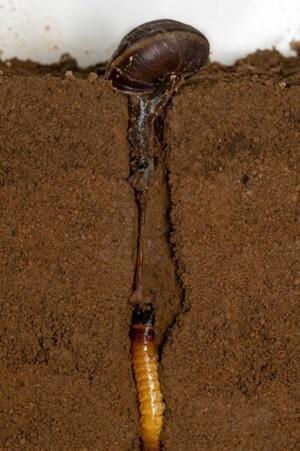The larvae of a strange click beetle that ambush and predate on snails in underground burrows have been found in the Ryukyu Islands. This discovery was made by Project Researcher Nozomu Sato of the Graduate School of Urban Environmental Sciences and Project Researcher Aiki Yamada of Graduate School of Science at Tokyo Metropolitan University, together with Chief Researcher Hisanori Okamiya of the Museum of Natural and Environmental History in Shizuoka. Snail predators that use burrows have never been reported before, making this the first discovery of such a predator. The findings were published online in the journal Ecology.

Provided by Tokyo Metropolitan University
With their soft bodies hidden inside hard shells, snails make formidable yet attractive prey for many predators. As a result, some have evolved various traits to break through snails' defenses. For example, Damaster blaptoides, a member of the Carabidae family, preys on the soft parts of the snail body by plunging its elongated head into the mollusk shell. Larvae of terrestrial fireflies attack by using suckers on their abdomens to attach themselves to the snail shell. The Pareidae skillfully use their asymmetrical jaws to pull soft parts out of the snail shell. Snails respond to these attacks in a variety of ways, such as by spewing bubbly mucus, shaking their shells, and cutting their tails to defend themselves against predators. These unique coevolutionary relationships between snails and their predators have long been treated as useful models for studies on evolution.
The Ryukyu Islands is an area of high biodiversity in Japan, with a particularly large number of endemic species. Many of these species are at risk of extinction, and the detailed ecology of a vast number of them remains unknown. There is concern that some of them will become extinct before their ecology, or even their existence, is revealed. This awareness prompted the research group to conduct survey studies on the Ryukyu Islands.
During the survey, several shells of snails (Satsuma mercatoria, Acusta despecta despecta) were found to be arranged in an unnatural pattern. When the snails were found dead, all of them had their soft parts pulled into small burrows (holes) in the ground. The underground burrows extended 15 centimeters vertically, and unidentified larvae of a strange beetle were found at the bottom of the holes. The larvae were taken home to be hatched and were subsequently identified as click beetles (scientific name Anthracalaus sakaguchii).
This large click beetle is endemic to the Okinawa Islands and the Yaeyama Archipelago. Although it has been described as a new species for more than 90 years, no larvae were ever found, and its ecology remained a mystery. The genus Anthracalaus, which includes A. sakaguchii, has 17 known species from North America, Southeast Asia, and Australia. However, the larval stages of all of them were unknown. Therefore, this discovery is a great achievement, because it reveals the larval stage of a species whose ecology was unknown at the genus level.
Detailed observations of their predatory behavior in captivity have shown that the larvae ambush snails at the entrance to their burrows. When they bite a passing snail, they pull only the soft parts into the burrow to feed. When attacked by a predator, the snail would fight back by shaking its shell. However, because the soft body parts from its unprotected underside are being bitten off, it is unable to resist at all and is predated. The shell is trapped at the entrance of the burrow, allowing the larvae to efficiently pull out the soft parts and feed on them. Although shell-eating click beetles have been reported from overseas, this is the first time they have been found in Japan. Moreover, the unique predatory method of using burrows to attack snails is unprecedented among other organisms, making this the first report of its kind in the world.
The Museum of Natural and Environmental History, Shizuoka (Suruga ward, Shizuoka City, Shizuoka Prefecture) is currently holding a special exhibition showcasing the results of this research. For more information, visit the museum's website at https://www.fujimu100.jp/en/.
Journal Information
Publication: Ecology
Title: Ambush hunter attacks land snails in its burrow: Unique larval stage of the click beetle Anthracalaus sakaguchii
DOI: 10.1002/ecy.4245
This article has been translated by JST with permission from The Science News Ltd. (https://sci-news.co.jp/). Unauthorized reproduction of the article and photographs is prohibited.




